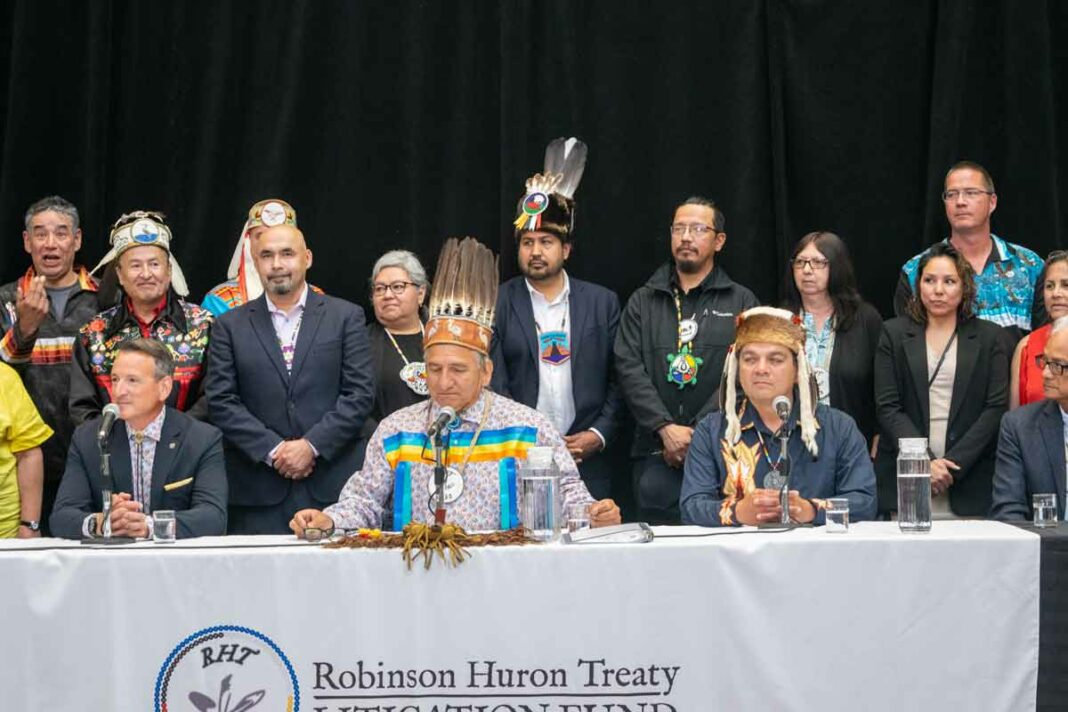Crown reaches ‘long overdue’ proposed settlement with Robinson-Huron Treaty chiefs
SUDBURY—Chiefs of Robinson-Huron Treaty (RHT) communities have reached a proposed $10 billion settlement with the governments of Canada and Ontario, regarding a breach of treaty that has continued into the modern era.
The RHT Litigation Fund announced the proposed settlement this past Saturday, June 17, at Laurentian University in Sudbury. The money is meant to correct more than a century of lost compensation, which the Crown owes the 21 RHT First Nations.
It does not address future annuities, which will be handled at a later date.
“The compensation from this settlement will ensure a stronger and brighter future for our people and our nations,” said Batchewana First Nation Chief Dean Sayers, one of the leaders of the RHT Litigation Fund.
“We see this settlement as an opportunity to show the commitment of both Canada and Ontario to respect and implement our rights affirmed in the treaty,” he said.
Ontario and Canada have each committed $5 billion toward the proposed settlement. Details of how that money will reach communities are not yet available, because the RHT Litigation Fund is working with the 21 First Nations to finalize that plan.
Each of the RHT First Nations will get a share of the proposed settlement, if ratified, and will decide what to do with its share. While some of the money will flow directly to individuals, a large portion will be set aside for community development purposes such as infrastructure upgrades and cultural supports.
The First Nations will vote on the settlement agreement, following consultations, before it faces a review by Ontario and Canada and, finally, endorsed in the Ontario Superior Court. More information about the process to come is available in the story ‘What happens next?’
Compensation frozen for 150 years
The RHT legal case has been underway for about 10 years. The First Nations began to formally organize on this effort in 2012, though advocates have been calling on the governments to fix the issue for generations.
This issue stems from the original treaty, which outlined the relationship between the colonial government and Anishinabek in an area roughly between Sault Ste. Marie and North Bay, and north of Lake Huron.
From the beginning, the treaty has represented a nation-to-nation relationship and offered a framework for resource-sharing and peaceful co-existence of the two peoples.
At the time it was signed, the treaty included a clause that First Nations would receive compensation each year, and that amount would be tied to the value of resources the colonial government would extract from the region.
The Ontario Superior Court ruled in 2018 that the original RHT from 1850 required the government to increase those annuities as the value of resource-extraction grew.
The annuity was originally set at $1.70 per person. It increased to $4 in 1874, but has not budged since, despite the massive value of resources that Northern Ontario has produced for colonial governments.
For instance, the Ontario Mining Association states that, across the province, mining extracted $11.1 billion worth of minerals in 2021 alone.
That has had major impacts. RHT Litigation Fund spokesperson Duke Peltier, of Wiikwemkoong, said the breach of treaty has caused First Nations to suffer economically, culturally and socially.
“It’s our people that have carried the burden of treaty for far too long. And this compensation from this settlement will ensure a stronger and brighter future for our people and our nations,” Mr. Peltier said.
Chief Sayers said although the relationship has been strained for many years, his people have always carried hope that the government would right its wrongs.
“It’s not been the best type of experience that we would have hoped for. But the sun has always been shining behind the clouds. The sun has always risen, every day, and will continue to rise,” he said.
“Community healthcare and education has suffered and our economies have been crushed through the impact and ongoing legacy of colonialism. The proposed settlement we’re announcing today is an opportunity for our communities to grow, prosper, and provide a sustainable future for our children,” said Chief Sayers.
Indigenous Relations minister says it’s
‘long overdue’
Alongside Chief Sayers and Mr. Peltier at the announcement were litigation lawyer David Nahwegahbow, from Whitefish River First Nation, federal Crown–Indigenous Relations Minister Marc Miller and Ontario Indigenous Affairs Minister Greg Rickford.
Minister Miller said the proposed settlement was a “game-changer” for the 21 RHT First Nations.
“This is about the partner, Canada, Ontario, paying its bills that are past due,” he said. “The Crown did not fulfill its treaty promises.”
The minister acknowledged the many people who have advocated for a settlement but have since passed on to the Spirit World. He said that, while the 1850 RHT took five years to create, it has taken more than 170 to fix.
“That treaty went unfulfilled, and the obligation broken. And this isn’t about one parcel of land in Canada. It is about the entire relationship upon which this country has essentially been built,” he said, adding that there are many non-Indigenous people who don’t understand the importance of these treaties, or that they themselves are treaty people.
Minister Rickford said the negotiations on this proposed settlement have been underway for several months, and only happened because both sides worked hard to form relationships between each other.
“We had established trust and confidence. Trust, not just in each other, but in a process. We found ourselves having the kinds of conversations that would lead us to today,” he said.
The minister said he wanted the relative speed on the settlement to signify that it wouldn’t take 173 years to deal with similar issues in the future.
Lack of communication
difficult but necessary
A key part of forming those relationships was the existence of strict non-disclosure agreements for all members of the negotiations.
Chief Sayers said he struggled with the limited updates he was able to share during the process, but it was important so everyone in the discussions could feel safe and comfortable speaking openly and honestly.
“Believe me, we were frank in our discussions with each other,” he said, adding that the process became more successful after “we really trusted each other in the relationships and incorporated ceremony.”
The chief said reconciliation is not possible to achieve within courtrooms, but he said the co-operation on both sides has supported that process.
“As Anishinaabe people, settler court processes are not our preferred venues for resolution. However, we have accepted that it is necessary and we have made tremendous progress,” he said. “True and lasting reconciliation is only possible when Canadian governments honour our nation-to-nation relationship.”
‘Renewal of the relationship’
Mr. Peltier said “the primary objective all along has been to renew the relationship” between the Crown and First Nations.
“Unfortunately, it took us launching a court case to compel the Crown to sit at the table, to realize that we can accomplish more together, outside of a court process. And the result of the negotiations clearly established a path forward for us,” he said.
Mr. Peltier recalled the original Covenant Chain from the Treaty of Niagara that said settlers and Indigenous people would share the land, offering help to each other when needed, but ultimately continuing their own ways of life.
Minister Miller said there is a “healthy suspicion” among many First Nations toward the Crown, owing to generations of broken promises. He said the Canadian government is committed to rebuilding the relationship.
“To the credit of the leadership here today, they have made sure that they have wrapped this in ceremony and in the spirit and intent of the treaty that was signed in 1850.”
Chief Sayers said the past court processes have brought forth many historical perspectives from Elders, and that the courts have affirmed that Indigenous oral tellings of history are of equal force to legal documentation.
“This case has really brought a lot of beautiful perspectives to light and we’re in a better place because of it. And our people will be richer because of it,” he said.
The negotiating team for the annuities case who guided the process through its final stages were: Chief Dean Sayers, Chief Patsy Corbiere, former Wiikwemkoong Ogimaa Duke Peltier, Peter Recollect, former Ontario regional chief Angus Toulouse, Roger Daybutch of the Mississauga First Nation and Anishinaabek Nation director Mike Restoule.





